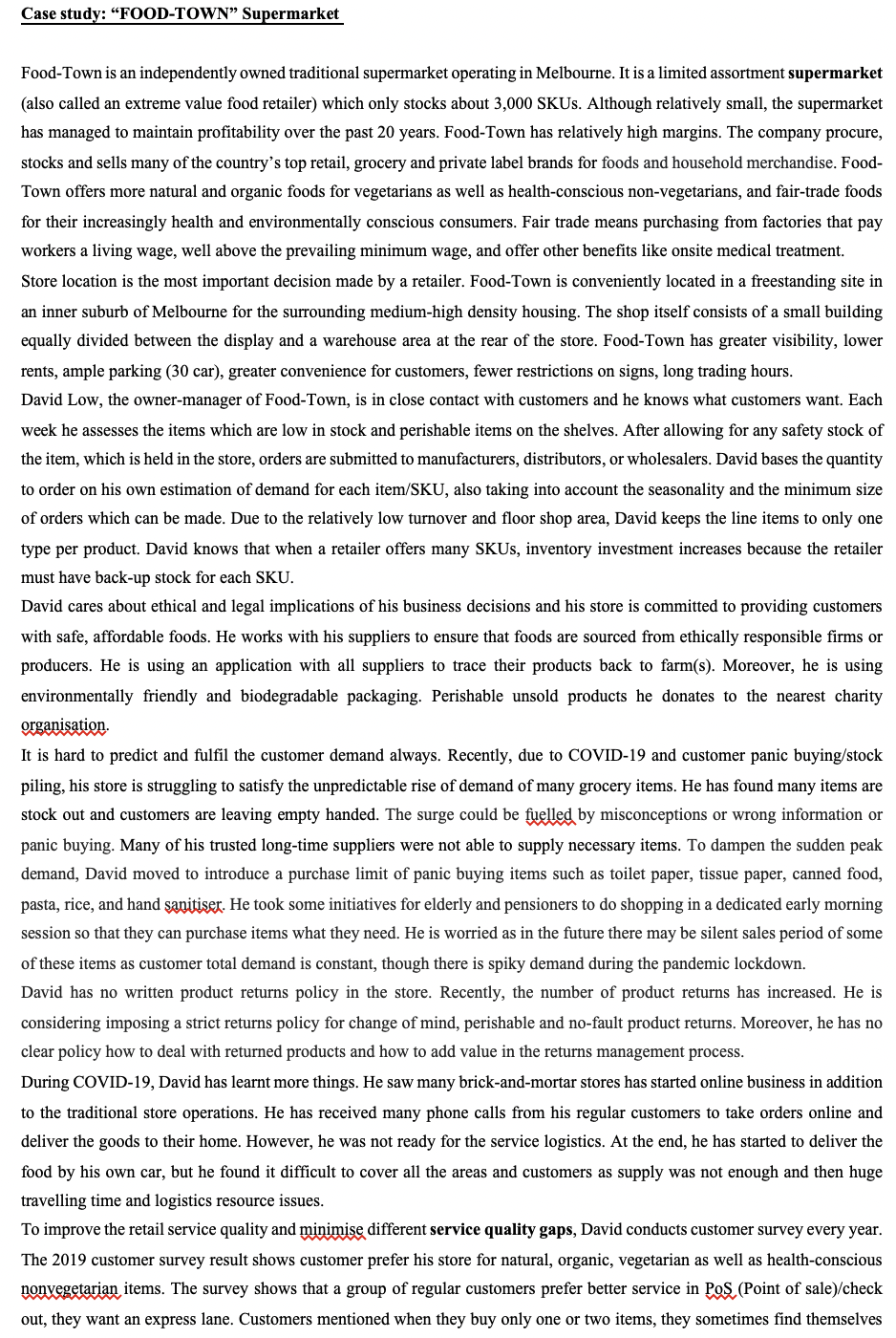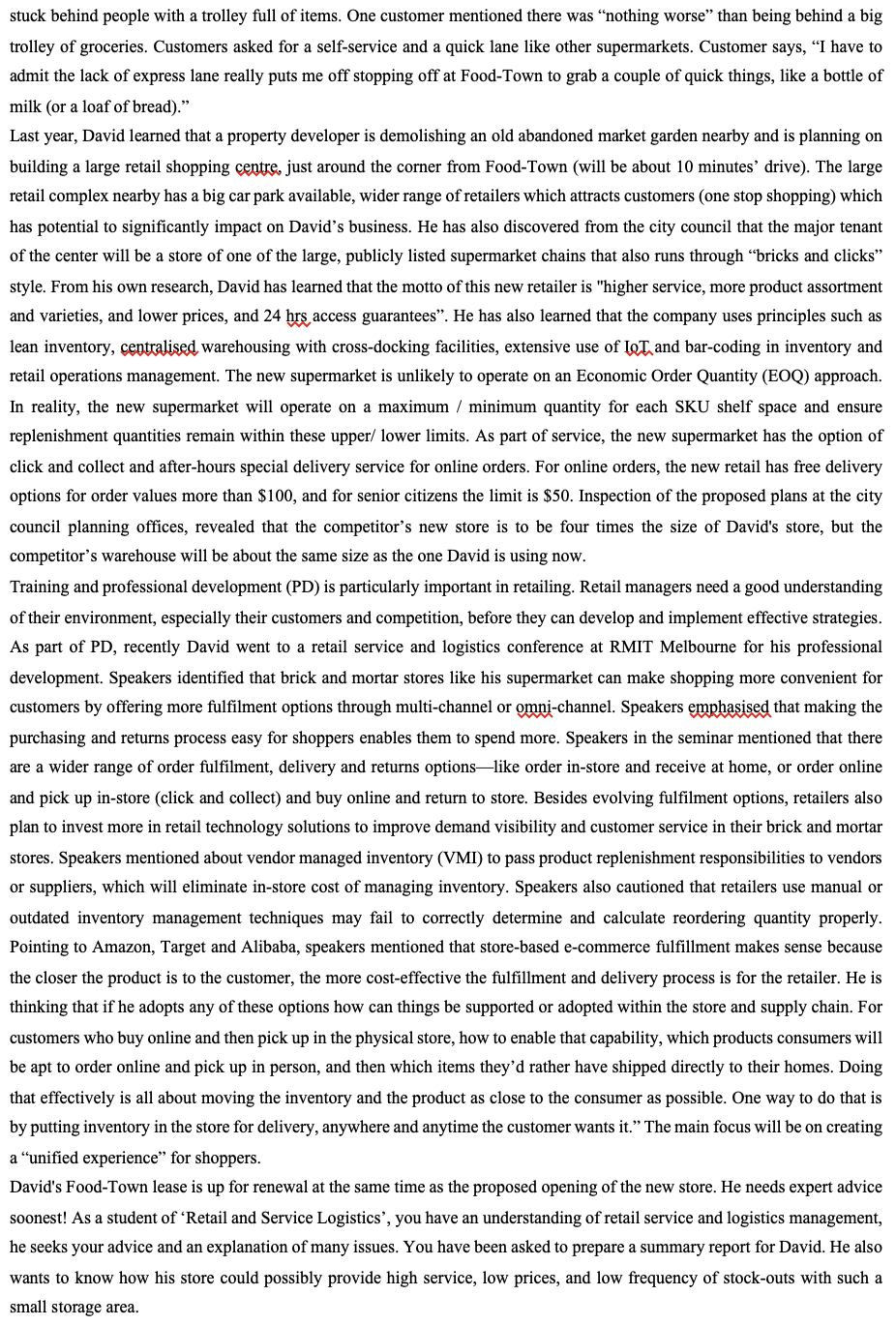Corporate Social Responsibility: What is corporate social responsibility (CSR) in retail business? How has Food-Town can incorportae more CSR into their activities? Give two examples. Can you solve this question for me which is linked with case study? This subject is about RETAIL AND SERVICE LOGISTICS. Please make sure to read the case study. I also provided the case study in image. Please just write in 150 words.
Corporate Social Responsibility: What is corporate social responsibility (CSR) in retail business? How has Food-Town can incorportae more CSR into their activities? Give two examples. Can you solve this question for me which is linked with case study? This subject is about RETAIL AND SERVICE LOGISTICS. Please make sure to read the case study. I also provided the case study in image. Please just write in 150 words.
Purchasing and Supply Chain Management
6th Edition
ISBN:9781285869681
Author:Robert M. Monczka, Robert B. Handfield, Larry C. Giunipero, James L. Patterson
Publisher:Robert M. Monczka, Robert B. Handfield, Larry C. Giunipero, James L. Patterson
ChapterC: Cases
Section: Chapter Questions
Problem 5.3SD: Scenario 4 Sharon Gillespie, a new buyer at Visionex, Inc., was reviewing quotations for a tooling...
Related questions
Question
Question:
Corporate Social Responsibility: What is corporate social responsibility (CSR) in retail business? How has Food-Town can incorportae more CSR into their activities? Give two examples.
Can you solve this question for me which is linked with case study? This subject is about RETAIL AND SERVICE LOGISTICS. Please make sure to read the case study.
I also provided the case study in image. Please just write in 150 words.

Transcribed Image Text:Case study: "FOOD-TOWN" Supermarket
Food-Town is an independently owned traditional supermarket operating in Melbourne. It is a limited assortment supermarket
(also called an extreme value food retailer) which only stocks about 3,000 SKUs. Although relatively small, the supermarket
has managed to maintain profitability over the past 20 years. Food-Town has relatively high margins. The company procure,
stocks and sells many of the country's top retail, grocery and private label brands for foods and household merchandise. Food-
Town offers more natural and organic foods for vegetarians as well as health-conscious non-vegetarians, and fair-trade foods
for their increasingly health and environmentally conscious consumers. Fair trade means purchasing from factories that pay
workers a living wage, well above the prevailing minimum wage, and offer other benefits like onsite medical treatment.
Store location is the most important decision made by a retailer. Food-Town is conveniently located in a freestanding site in
an inner suburb of Melbourne for the surrounding medium-high density housing. The shop itself consists of a small building
equally divided between the display and a warehouse area at the rear of the store. Food-Town has greater visibility, lower
rents, ample parking (30 car), greater convenience for customers, fewer restrictions on signs, long trading hours.
David Low, the owner-manager of Food-Town, is in close contact with customers and he knows what customers want. Each
week he assesses the items which are low in stock and perishable items on the shelves. After allowing for any safety stock of
the item, which is held in the store, orders are submitted to manufacturers, distributors, or wholesalers. David bases the quantity
to order on his own estimation of demand for each item/SKU, also taking into account the seasonality and the minimum size
of orders which can be made. Due to the relatively low turnover and floor shop area, David keeps the line items to only one
type per product. David knows that when a retailer offers many SKUs, inventory investment increases because the retailer
must have back-up stock for each SKU.
David cares about ethical and legal implications of his business decisions and his store is committed to providing customers
with safe, affordable foods. He works with his suppliers to ensure that foods are sourced from ethically responsible firms or
producers. He is using an application with all suppliers to trace their products back to farm(s). Moreover, he is using
environmentally friendly and biodegradable packaging. Perishable unsold products he donates to the nearest charity
organisation.
It is hard to predict and fulfil the customer demand always. Recently, due to COVID-19 and customer panic buying/stock
piling, his store is struggling to satisfy the unpredictable rise of demand of many grocery items. He has found many items are
stock out and customers are leaving empty handed. The surge could be fuelled by misconceptions or wrong information or
panic buying. Many of his trusted long-time suppliers were not able to supply necessary items. To dampen the sudden peak
demand, David moved to introduce a purchase limit of panic buying items such as toilet paper, tissue paper, canned food,
pasta, rice, and hand sanitiser. He took some initiatives for elderly and pensioners to do shopping in a dedicated early morning
session so that they can purchase items what they need. He is worried as in the future there may be silent sales period some
of these items as customer total demand is constant, though there is spiky demand during the pandemic lockdown.
David has no written product returns policy in the store. Recently, the number of product returns has increased. He is
considering imposing a strict returns policy for change of mind, perishable and no-fault product returns. Moreover, he has no
clear policy how to deal with returned products and how to add value in the returns management process.
During COVID-19, David has learnt more things. He saw many brick-and-mortar stores has started online business in addition
to the traditional store operations. He has received many phone calls from his regular customers to take orders online and
deliver the goods to their home. However, he was not ready for the service logistics. At the end, he has started to deliver the
food by his own car, but he found it difficult to cover all the areas and customers as supply was not enough and then huge
travelling time and logistics resource issues.
improve the retail service quality and minimise dif service quality gaps, David conducts customer survey every year.
The 2019 customer survey result shows customer prefer his store for natural, organic, vegetarian as well as health-conscious
nonvegetarian items. The survey shows that a group of regular customers prefer better service in POS (Point of sale)/check
out, they want an express lane. Customers mentioned when they buy only one or two items, they sometimes find themselves

Transcribed Image Text:stuck behind people with a trolley full of items. One customer mentioned there was "nothing worse" than being behind a big
trolley of groceries. Customers asked for a self-service and a quick lane like other supermarkets. Customer says, "I have to
admit the lack of express lane really puts me off stopping off at Food-Town to grab a couple of quick things, like a bottle of
milk (or a loaf of bread)."
Last year, David learned that a property developer is demolishing an old abandoned market garden nearby and is planning on
building a large retail shopping centre, just around the corner from Food-Town (will be about 10 minutes' drive). The large
retail complex nearby has a big car park available, wider range of retailers which attracts customers (one stop shopping) which
has potential to significantly impact on David's business. He has also discovered from the city council that the major tenant
of the center will be a store of one of the large, publicly listed supermarket chains that also runs through "bricks and clicks"
style. From his own research, David has learned that the motto of this new retailer is "higher service, more product assortment
and varieties, and lower prices, and 24 hrs access guarantees". He has also learned that the company uses principles such as
lean inventory, centralised, warehousing with cross-docking facilities, extensive use of IoT and bar-coding in inventory and
retail operations management. The new supermarket is unlikely to operate on an Economic Order Quantity (EOQ) approach.
In reality, the new supermarket will operate on a maximum / minimum quantity for each SKU shelf space and ensure
replenishment quantities remain within these upper/ lower limits. As part of service, the new supermarket has the option of
click and collect and after-hours special delivery service for online orders. For online orders, the new retail has free delivery
options for order values more than $100, and for senior citizens the limit is $50. Inspection of the proposed plans at the city
council planning offices, revealed that the competitor's new store is to be four times the size of David's store, but the
competitor's warehouse will be about the same size as the one David is using now.
Training and professional development (PD) is particularly important in retailing. Retail managers need a good understanding
of their environment, especially their customers and competition, before they can develop and implement effective strategies.
As part of PD, recently David went to a retail service and logistics conference at RMIT Melbourne for his professional
development. Speakers identified that brick and mortar stores like his supermarket can make shopping more convenient for
customers by offering more fulfilment options through multi-channel or omni-channel. Speakers emphasised that making the
purchasing and returns process easy for shoppers enables them to spend more. Speakers in the seminar mentioned that there
are a wider range of order fulfilment, delivery and returns options-like order in-store and receive at home, or order online
and pick up in-store (click and collect) and buy online and return to store. Besides evolving fulfilment options, retailers also
plan to invest more in retail technology solutions to improve demand visibility and customer service in their brick and mortar
stores. Speakers mentioned about vendor managed inventory (VMI) to pass product replenishment responsibilities to vendors
or suppliers, which will eliminate in-store cost of managing inventory. Speakers also cautioned that retailers use manual or
outdated inventory management techniques may fail to correctly determine and calculate reordering quantity properly.
Pointing to Amazon, Target and Alibaba, speakers mentioned that store-based e-commerce fulfillment makes sense because
the closer the product is to the customer, the more cost-effective the fulfillment and delivery process is for the retailer. He is
thinking that if he adopts any of these options how can things be supported or adopted within the store and supply chain. For
customers who buy online and then pick up in the physical store, how to enable that capability, which products consumers will
be apt to order online and pick up in person, and then which items they'd rather have shipped directly to their homes. Doing
that effectively is all about moving the inventory and the product as close to the consumer as possible. One way to do that is
by putting inventory in the store for delivery, anywhere and anytime the customer wants it." The main focus will be on creating
a "unified experience" for shoppers.
David's Food-Town lease is up for renewal at the same time as the proposed opening of the new store. He needs expert advice
soonest! As a student of 'Retail and Service Logistics', you have an understanding of retail service and logistics management,
he seeks your advice and an explanation of many issues. You have been asked to prepare a summary report for David. He also
wants to know how his store could possibly provide high service, low prices, and low frequency of stock-outs with such a
small storage area.
Expert Solution
This question has been solved!
Explore an expertly crafted, step-by-step solution for a thorough understanding of key concepts.
Step by step
Solved in 3 steps

Recommended textbooks for you

Purchasing and Supply Chain Management
Operations Management
ISBN:
9781285869681
Author:
Robert M. Monczka, Robert B. Handfield, Larry C. Giunipero, James L. Patterson
Publisher:
Cengage Learning

Purchasing and Supply Chain Management
Operations Management
ISBN:
9781285869681
Author:
Robert M. Monczka, Robert B. Handfield, Larry C. Giunipero, James L. Patterson
Publisher:
Cengage Learning